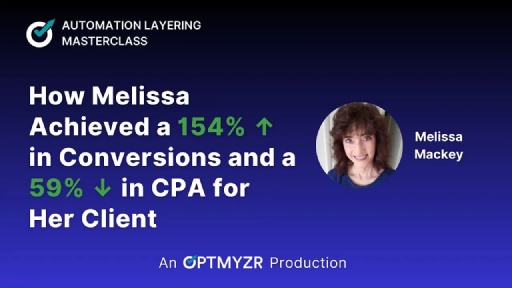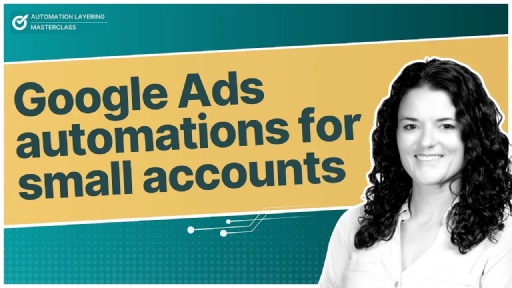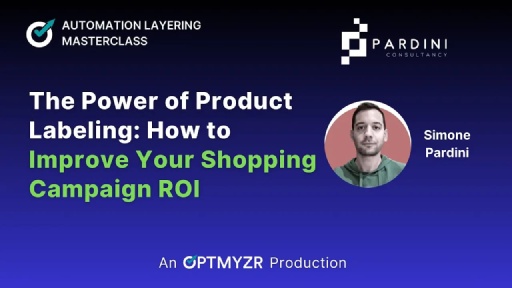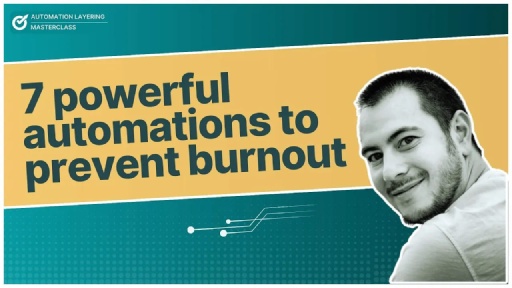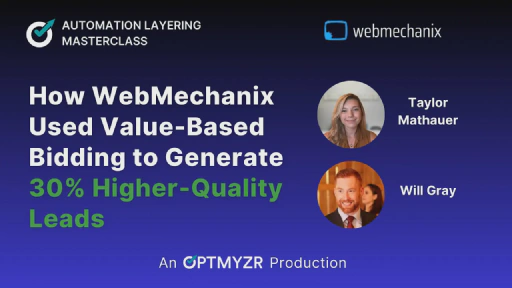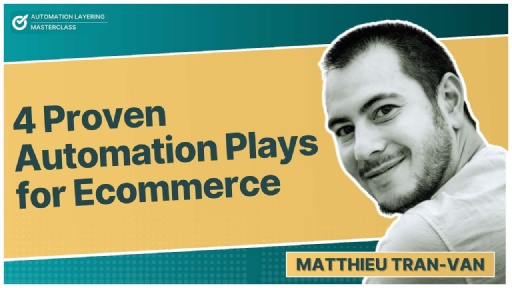
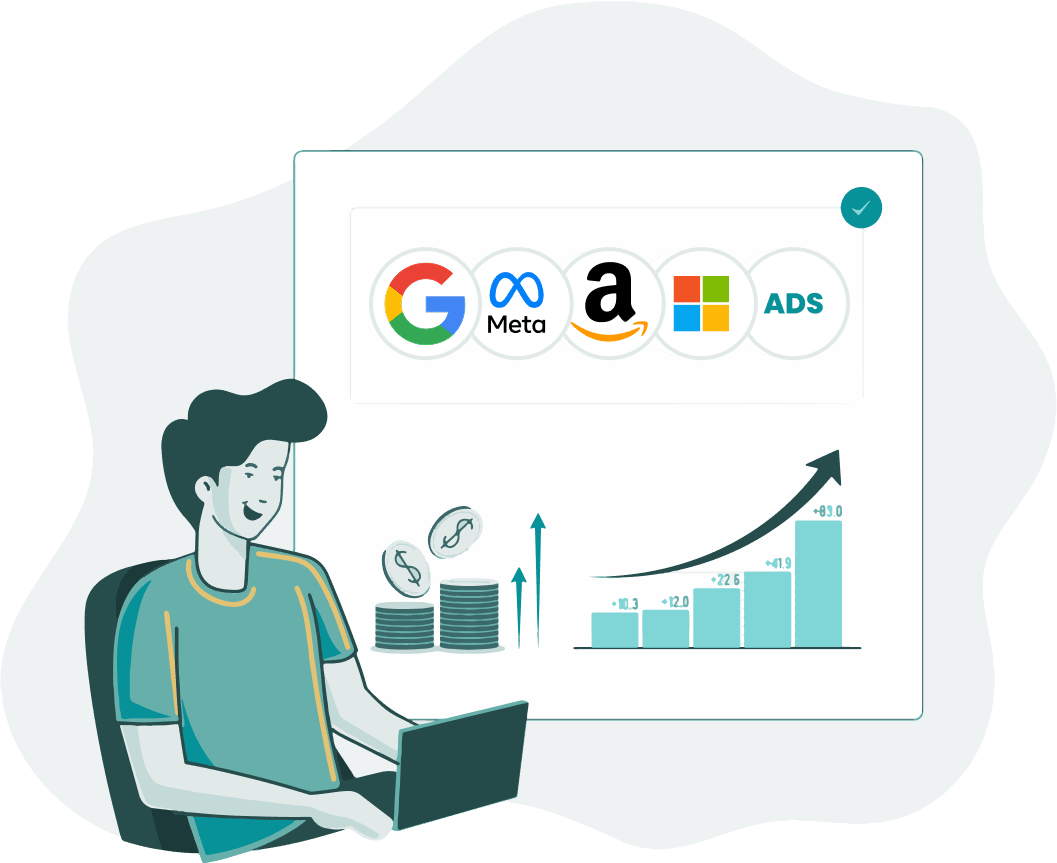
Episode Description
Joey Bidner of Bidner Search Engine Marketing, for a long time, liked to run his ad campaigns manually. In this conversation with our CEO, Frederick Vallaeys, he shares his story of how he started putting more trust in PPC automation and what powerful automations he is currently running to help his clients grow using paid search.
Episode Takeaways
One of the most significant transitions for advertisers, especially in the last few years has been the shift from manual, granular campaign management to embracing AI and automation.
Joey and Fred discuss how advertisers like him, who were once skeptical to automation can strategically incorporate automation into their workflows without sacrificing strategic thinking and deep analysis.
Read on to understand how you can leverage well-implemented automation for better results with your PPC campaigns.
1. The transition from manual to automated PPC management
For a large part of his career, Joey relied on manual PPC management due to the limitations of early automation tools.
“Back then when I was at the agency world you know they were pushing the automated bidding strategies which at the time were not as good as they are now” shares Joey.
The granular control offered by manual campaign management allowed advertisers to unlevel the playing field through meticulous bid adjustments and data analysis.
But soon enough, as the number of clients he managed grew, monitoring multiple accounts with varying budgets became quite challenging. Aside from this the shift toward broad match keywords and AI-driven campaign types also contributed to Joey’s decision to include automation in his approach for striking the right balance.
But, instead of implementing automation for its sake, he used a targeted approach where he began by focusing on one problem at a time. This way he was able to properly evaluate the effectiveness of one automated solution before moving to the next. This approach also allows him to maintain client trust during the transition, as he can clearly articulate the specific purpose behind each automation implementation.
2. Automation as a way to scale your efficiency rather than a replacement for strategy
Although he added automation to his strategy, Joey emphasizes that it simply accelerated his ability to implement strategic decisions rather than impacting the sophistication of his approach.
“In transitioning from doing all these these very manual adjustments as I used to do, into using automation, it’s not that the analysis is any less sophisticated. I’m still diving into the data in a very deep way but I’m just getting to that point of taking action much quicker” explains Joey.
Joey also shares that automation helps him run better, more disciplined tests while still relying on human judgment for test design and interpretation.
3. The role of alerts, scripts, and community resources
Joey utilizes scripts and alert systems (e.g., disapproval notices, performance fluctuations) to maintain oversight and prioritize focus areas.
He specifically highlights a script that solves notification challenges with the Google Merchant Center.
“I’ve been finding just like product disapproval scripts really good. There’s a really good one from Nils Rooijmans, and he’s got a really simple script that just runs on whatever frequency you want and it sends you an email of your disapprovals. What’s great is that it also links you to the Google literature on the information on what that disapproval is or means” said Joey.
This way, instead of overwhelming users with trivial alerts or missing critical issues when notifications are disabled, you get a more carefully calibrated alert system that informs you of meaningful changes while still maintaining comprehensive coverage. Similarly community-shared scripts and tools provide immense value for both time-saving and discovering blind spots.
4. Is there a universal campaign type that’s ‘best’ for you?
One of Joey’s core beliefs is that no single campaign type fits every client or situation.
“I think the one thing thing that people do wrong is is is think that there is like one campaign type that solves a problem. I don’t find that there is one formula that applies to one client. I have some clients that do amazing with feed only PMax while other clients, even in the same kind of vertical, it just did not work because of a number of reasons.” explains Joey.
According to him:
- PMax, standard shopping, or any other campaign type could work—it’s about context, testing, and alignment with user behavior.
- Rigid formulas often fall short; adaptability and experimentation win long-term.
- Success is tied to an advertiser’s ability to test intelligently and act on results quickly.
Tools & Resources
Episode Transcript
Frederick Vallaeys: Hello and welcome to another episode of Automation Layering Masterclass. My name is Fred Vallaeys. I’m your host for this show. I’m also CEO and co-founder at Optmyzr, a PPC tool management company. For today’s episode we have Joey Bidner from Bidner Search Marketing Agency and he is interesting because for a long time he liked to run campaigns manually and he didn’t really believe in automation or he didn’t see the value in automation that much. But recently with all of the AI coming out and just the way that PPC and marketing is shifting, Joey took another look and we’re going to hear about his path from being fairly manual to having added automation to his workflows.
So with that let’s get rolling with this episode.
Hey Joey thanks for coming on and sharing with people what your path has been.. But before we go into that, tell folks a little bit more about who you are and what you do.
Joey Bidner: Yeah so I’m a Google ads freelancer. I manage a lean list of small and large clients and focus solely on Google ads. So that’s everything from lead gen to ecommerce, YouTube, display, feed management and everything related to just Google ads.
My background like I got started in the agency world and had a nice long run working at agencies; a few different ones and my reason for switching over to freelance was what excited me about PPC was using cutting edge strategies and moving quickly as the environment moves around us. And working at agencies at times can be a bit slow and you know you have to wait for the agency to approve those new campaign types or you can only move as fast as your team sometimes. And I really like to dig into the weeds of things try new cutting edge stuff. So I left a number of years ago. As a freelancer it’s been great because of that flexibility and ability to change workflows, try new things and that brings us to where we are today.
Frederick Vallaeys: Nice yeah and so that’s a story that I think we hear quite a bit. So at an agency often the playbook is— take an existing methodology which could be an amazing best practice but then try to deploy it and scale it across many clients and that’s how you make your money. And then when we work with in-house teams it seems like they always kind of want to push the envelope and do something a little bit more custom, a little bit more different, and try that new thing. But I understand we’re in an agency where there’s sort of that playbook that you need to stick to in order to make things efficient. It can be harder to be allowed to push a little bit further.
I guess that was your initial drive too then for manual management right because you didn’t want to be boxed in by what a tool allows you to do. So what did that look like for you?
Joey Bidner: So you know back then when I was in the agency world you know they were pushing the automated bidding strategies, which at the time were not as good as they are now. We’ll get into that but I do love a lot of those in-platform automations because they’ve gotten better.
But years ago we were really able to unlevel the playing field as some may say. When you really deep dived into data, making manual adjustments, very nerdy, deep level tweaks of bid adjustments and all this stuff. And at the time that was what I really wanted to do but agencies kind ofweren’t really for it for a number of reasons. So to get back to your question though, yeah at the time that worked really well and I was really excited about that type of management. But as things kind of changed not just with you know bid management styles, but also campaign types, that’s where we’re facing yet another precipice of it’s time to learn this new tool and deploy it. You can’t always do that off the cuff within an agency so I’ve been really enjoying the process as a freelancer of learning these cutting edge strategies and having the ability to come to a client and say hey you know do you want to try this.
I think a big part of trying something new is having the right type of client to run with it and picking the right instances to really test things.
Frederick Vallaeys: So you obviously end up hitting some limits if you’re doing things manually and trying these new strategies. So when you started looking at tools, like was any of this driven by the new wave of generative AI or what kind of sort of pushed you to maybe start going through that transition?
Joey Bidner: So fast forwarding to now, I think there’s a big difference as well when looking at the automation tools within the platform and then automation tools outside of the platform. My drive to using automation tools outside of the platform came from specific questions that I had. I’ll give you an example. One situation that I really turned to Optmyzr, for example was I’ve got a lot of different accounts with different ads spends right and when you have, let’s say an account with a very large ad spend versus one with very small, you’re running tests in both. When you have a client that’s got a very small ad spend you often need to let that test run for quite a bit longer before you can really evaluate its effectiveness. So it’s like okay I need to give this a month before I can really evaluate if that test works. You’re not in that account as much day to day right and in that time period where maybe I’m giving time for data to mature I still want eyes on the account. Those bigger accounts you’re in there every day. You notice when there’s a little fluctuation.
But those smaller accounts where you’re waiting for some data to mature you’re not in there every day so you might miss that little hiccup or change in data. Maybe a new player came in, CPCs changed, you’re no longer serving as you were. So you know I’ve been using Optmyzr, for example to set up some alerts and I’ve been really enjoying the alerts functionalities where I can layer in something that says okay look at the last two weeks of data based on a particular KPI. Compare it to the previous two weeks of data and notify me when there is a 50% drop in that KPI. And then that allows me to just have some safeguards in place for that in between the time where I’m not in the account every day you know. So that was my first reason to go into using some of these platforms and then once you go in you realize oh my goodness there is so much to do and try. And you know I’m at a process now where I’m figuring out you which questions need to be answered.
Also I think an important part of this is not necessarily feeling like you need to do everything all at once. You don’t need to have every automation layer, you don’t need to have every alert. You can get easily overwhelmed so I think my approach has been a bit of a slower one where I’m taking taking it at that kind of question by question basis of — okay I’ve got this problem what can I use to solve it and being willing to kind of you know learn what’s out there to to get to the bottom of it.
Frederick Vallaeys: Yeah now that’s fascinating right. So because you basically talked about in-platform bid automation which is at this point more or less a given, it’s quite hard not to use that, given the context of sure you don’t have to automate your bids but broad match is so broad that you really want some sort of automated bidding to make sure that it’s not overspending on these crazy broad matches that you can’t really control that well anymore.
And so as you’ve been forced to to adapt your management style, you’re basically putting in place these safeguards so that the automation, and by the way the automations from Google are fundamentally built to help Google investors. The stock price needs to head in one direction. Obviously, I mean I was at Google before so I don’t think they’re an evil company and I think they have their heart in the right place in most cases and they also very well understand that if you give an advertiser horrendous results, well they’re going to leave and they’re going to go find a different ad platform to be on. And so that’s not good for anyone but you know if you can squeeze that extra 1 or 2% out of them by you know maybe being a little bit more broad or having a little bit more of an aggressive bid, like they’re probably going to do that type of stuff as well. And that’s where it’s nice I think to have someone like Joey or someone else on your account who’s got your back and has your best interest in mind. But like you said it’s not always possible like there’s only so many, well there’s 24 hours in a day, but there’s only so many hours that we can be looking at accounts and for me that was like the discovery of scripts.
It was like wow now I can look every single hour and like even if something’s a little bit off for that one hour I can get a notification.
Joey Bidner: I’ve also been enjoying kind of exploring the world of scripts and there’s a lot of amazing resources out there and people who are really willing to share their scripts. There’s a whole great community of these tools that you can implement, that can answer a question that you didn’t even know there was an answer to, that you thought you had to do manually and always check. So I’ve been really enjoying that.
Frederick Vallaeys: Is there any like particular script that lately has stood out to you?
Joey Bidner: So a lot of the ones that I’ve been using to be honest, they’re quite simple. Like a lot of the the most effective ones I find are the simple ones. For example one of the things is that I find merchant center doesn’t have the greatest notification system or if you’re at any point tired of getting a lot of really useless notifications, you turn it off and then you don’t get the important ones.
So I’ve been finding just like product disapproval scripts. There’s a really good one from Nils, I’m not even going to try to pronounce his last name and he’s got a really simple script that just runs up, obviously whatever frequency you want, and it sends you an email of your disapprovals and then what’s great is that it also tells you what it’s disapproved for and then right in that same line, links you to the page, the Google literature on the information, on what that disapproval is or means. And you know sometimes there’s some weird disapprovals you might have not seen before so it’s just really helpful and gets you to where you need to go quicker and you don’t miss that disapproved product where you know nothing’s worse than you know performance has dropped over the last couple weeks. You don’t really know why then you realize oh goodness like the product’s been disapproved for the last two weeks. So ’ve been really enjoying that one.
And some other big ones that I like are the Mike Rhodes script, just for data transparency for PMax. That one’s been really helpful for just like data insights as well as some product segmentations for like zombie skew identification and stuff like that. He’s got a paid version and a free version. I’ve used both and they’re both great and both serve their purpose.
Frederick Vallaeys: Nice. And again it sounds like it’s really a lot of monitoring and alerting and insights because ultimately with the Mike Rhodes PMax script, it basically tells you where your money is being spent in these PMax campaigns.
Now if you want to act on that, you still have to be an expert and you still have to know what to do with that which settings and tweaks to do. But when it comes to like these alerts you kind of alluded to the fact that with merchant center there’s way too many alerts. So people turn them off and this is alert fatigue and there’s been studies done, like in hospitals there’s so many alerts beeping at the nurses that they ended up tuning out some of the really important ones and then a patient goes into cardiac arrest and so it’s like how do you figure out like what actually matters? And what needs a quick response time? With PPC, its a little bit less life and death but I think it’s a frustration a lot of people have. So like what are your tips and tricks? Or how has Optmyzr or any other tool helped you sort of like dial it into the level that you think it gives you the insight that you want.
And you were even talking about like two weeks versus two weeks of data. Like so clearly your thinking about look back windows and how do you go about all of that?
Joey Bidner: I think when it comes to alerts it can be really easy to go a little bit too far. I’ll give you an example. One thing I don’t want is something alerting me based off of a daily trend and there are a lot of alert platforms out there that let you know oh like today your CPC spiked to 50%.
I don’t even want to know about daily fluctuations. I want to know about trend changes so I find that when it comes to picking and choosing what kind of alerts you want, based on what kind of information you would actually take action on. You know there always has to be a so what moment in every piece of data that you read. You see a piece of data, you need to say to yourself okay so what? What would be the action I would take on that? On a daily fluctuation there’s often very little so what. You’re going to be like okay I’m going to wait till tomorrow and see if that data is the same. Then so I like to look at trend based data which is why I baked in using the rule engine on Optmyzr. I baked in a lot of those look back windows into my alerts.
Frederick Vallaeys: So you played with the custom look back window capability of rule engine?
Joey Bidner: Yeah exactly. So I’ll set the automation to run every week or every two weeks and it’s looking at these last two weeks compared to the two weeks before and then it’s only notifying me if there’s like a 50% difference. I don’t really care if it’s a 20% difference because again, 20% difference I consider fluctuation. Things always go up, go down and I want to know if there’s a drop off because that indicates that there’s been a change in the landscape in some way. Then usually what I’ll do is I’ll take that piece of information and then I’ll go to Optmyzr.
I love the PPC investigator where it allows you to really quickly narrow in on what’s fluctuated, what’s changed, and then I can take that piece of data and go back into Google ads to do even more thorough investigation. What I find interesting about all this is that in transitioning from doing all these very manual adjustments as I used to do, into using automation, it’s not that the analysis is any less sophisticated. I’m still diving into the data in a very deep way but I’m just getting to that point of taking action much quicker. So I’m moving a lot more efficiently but still with the same level of sophistication and I think that’s where PPC is going. You know crystal ball in front of me I think that in the next few years to be honest I think industrywide management pricing is going to change. I think we’re going to be expected to manage more clients for a little bit less but with the same level of sophistication and that’s what I like.
I find these automations allow you to do it’s still the same level of sophistication. You’re just getting to where you need to go a little bit quicker and that process requires an open mind to adjust to and this is where one thing I kind of wanted to mention where I think PPC managers need to be flexible in our processes. We can’t be romantic about our processes. We need to be willing to change them and that is difficult. It is difficult to change something in our workflow that we know has worked so well for us and I don’t think it’s wise to change too late where you’re forced to. As soon as you know we’re starting to see things shift in Google ads, we got to say okay rolling up my sleeves, got to change my process a little bit, got to learn what comes in this new territory. I think that is becoming a big part of the job.
Frederick Vallaeys: That’s well said. I mean if you’re not going to change the process then someone else is going to do it and have better results and you’re going to lose business to them. So it’s better to cannibalize yourself than to have someone else do it.
And you’re also kind of alluding to sort of like this Bidner formula. It’s almost like it’s your smarts and your strategies that become the secret sauce. And it’s your ability, thanks to technology, to scale this and deploy it more widely. But, and now we’re going back a little bit to this is more the agency model. It’s about having lots of clients deploying the same sort of methodology but at some level if that’s the right strategy and the right workflow then it is highly valuable. It is going to save advertisers a lot of wasted ad spend. It’s going to reprioritize to what makes the most sense, it’s going to make sure that the ROAS targets are tied to actual business objectives like profits. All that takes a lot of time. I was going to joke at the beginning too that you know when you said you just do Google ads it’s like oh yeah that’s that’s not much these days right? That’s just like a gajillion campaign types and 15 different systems to manage it all and bring it together. So you know some of the strategies and the ideas are simple but the execution can be really tedious.
Joey Bidnes: Oh yeah and I think that the strategy portion, that’s one thing that I think is going to remain for a while. Like yeah our workflows of button pushing is changing but being able to understand consumer behavior and how to apply this complex platform to a specific business’s needs to adjust and get in front of the right consumer considering their behavior. Like that is the portion that no matter how much automation you have will still require, I think a human brain to interpret and I just find the automations just help us get to that decision-making point a little bit quicker.
Frederick Vallaeys: So what’s one common PPC myth that you wish you could debunk? Like what’s one thing that people do wrong?
Joey Bidner: So this is going to be kind of a weird answer but I think the one thing that people do wrong is is think that there is like one campaign type that solves a problem you know. It’s like every one of my clients, they come to me and it’s like oh should we use PMax? Should we use standard shopping? Should we use this? Should we use that? And to be honest my answer is always any of them could work and it’s our job to test to see which works best based off of your product category, your purchase intent, your consumer behavior.
I don’t find that there is one formula that applies to one client. I have some clients that do amazing with feed only Performance Max. Other clients, even in the same kind of vertical, it just did not work because of a number of reasons. So I think the biggest thing that people get wrong is thinking that you know PPC is as formulaic as it seems and again like I’m going to throw another quote out here to Chris Schaefer, another one of my favorite podcasts out there. He always says like our job is to test stuff. Performance can come, it can go, but our job is to test stuff and and make sure that we are never blinded by our own, call it consistent success or whatever it is. There’s always something you can test against or do. And yeah I guess I’ll answer it with that.
Frederick Vallaeys: Yeah well one of the thoughts in in my first book was that the winningest PPC advertisers, the one who’s got the best process around testing and is like you said, there’s not always one right solution. It’s a matter of how quickly can you identify the right test because not every test is going to be the right one and that’s where we are PPC doctors.
So we can look at an account and we contextualize it against everything else we’ve done and we can sort of prioritize, we can say like this is the most likely thing to work well for you but we can’t guarantee it and then it’s like having that process and like you alluded to as well, like if you have a very small client, is it the right thing to say we’re going to do this test. But it’s going to take four months to get to an answer because in four months the landscape changes. Like other things change, like could we make this test go faster? Could we limit it in some way? Could we like pump more volume through it to so that we can make that decision?
Because too many agencies and consultants I think, sit on tests and they’re like all happy like oh look I’m doing so many tests. But how many have you concluded or how many winning tests have you had if you keep doing AB test after AB test and six times in a row you’ve lost. Well that means that for six times in a row you’ve gotten that advertiser fewer conversions than they could have if you had just left the account alone. So doing the seventh test, is that really what you should be doing? So I love all of these ideas around testing and experimentation and just getting really good at it but again I think it comes back to like if you don’t have the right tool set then you’re just going to be hamstrung by your human ability to only look at an account so many times a day.
Whereas a tool could literally go in once an hour and say hey Joey this account just reached to statistical significance, it’s time for you to decide and move.
Joey Bidner: I can also tell you quite honestly there has been times as well where you know you got to test in one account, you got to test in another account, test another account, sometimes you kind of forget which tests you ran and when you ran it. So having some automations to just kind of ping you once in a while goes a long way. I find that’s where I’m using it the most is especially when your client list grows and you’ve got so many things floating, having good note taking is key. This is one thing that I’ve kind of changed my workflow on, is getting like a a note-taking software like a client, almost like a client management software and just using it for note taking and then having all those alerts and notifications through automations to keep all those tests top of mind and reminding you on when to follow up on them. And yeah giving things the maturing time that they need is so key.
Just like you said like there’s nothing worse than a short-lived test just to kind of show your client you’re doing tests. I’ll often say you know if a test needs a couple months and they’re thinking oh what am I paying you for if you’re just letting it sit for a couple months. Like yeah you’re paying me to not touch anything.
A poor manager will go in, try to feel busy, mess a bunch of stuff up while a test is running. You know our job isn’t button pushing. It’s insightful, long-term action.
Frederick Vallaeys: And that’s where the workflow is so important too. Because I think Google actually does not do a very good job of preventing you from invalidating a test and polluting the data and so it’s too easy for someone to go into an account and be like oh yeah there’s a cool negative keyword suggestion. Or that’s like a valid bid change and then you go and make it. It’s like oh well that was your control and now you’ve mucked up your control. And when you have to decide it’s no longer Apples to Apples right.
Your other point about note taking I love too because Google, in the campaign experiment setup, it’s very difficult to fully describe what is this test about in the name so that later on you’re going to actually remember it. I mean I look at a test and I’m like oh yeah we did a test in there two years ago on this one. But like what was that act? Did we add keywords? Did we change the ad text? Was it a budget thing? Like I don’t know. And so if you have good note-keeping tools or other technology you can really have your back in those cases.
What’s your favorite AI tool?
Joey Bidner: AI in terms of like generative?
Frederick Vallaeys: Sure generative or old school. But generative is more the topic on top of mind for most people I suppose.
Joey Bidner: Yeah when it comes to AI tools, to be honest I don’t use them all that much yet. I mean I use you know ChatGPT to help with ad copywriting. Stuff like that. I’m not as sophisticated in the AI tool use—full disclosure. I use ChatGPT to help with ad copywriting but that’s pretty much it right now.
Frederick Vallaeys: Cool. And yeah Chat or open AI GPT is built into Optmyzr as well. So if you want a quicker path to getting some headline suggestions, description line suggestions, we also have what we call the sidekick. So you can have a conversation about your account and one thing that’s nice as a consultant is you can say hey put a happy spin on how this account is doing and then you copy paste that and give it to the client to showcase how great you are. And then you turn around and you ask the same assistant but now tell me what I should work on so that next month I can have another happy conversation with the client, it tells you everything that’s broken and that you should be fixing.
Joey Bidner: Very cool. See I didn’t even know that some of those functions were built into Optmyzr. So there we go. This is already helpful for me.
Frederick Vallaeys: And it’s one of these weird things right, because like do you want to slap labels across every part of the tool and be like hey look we’re cool this is ChatGPT helping you do this versus it’s like well we are a tool that helps you amongst other things with ad generation. So it makes sense that we’re going to have some generative AI in that. And so we used more old school look throughout the campaign and if you had a specific ad group we’d say like look here’s a headline that you’ve used inside this campaign that had really good performance, maybe consider it for this new ad group or this new ad text where you need to put it in right. But over time it was like well generative can come up with some more creative things so now you have kind of like that choice as an advertiser and we just propose like here’s 10 headlines using different methodologies and then you pick what makes sense and make it really easy.
But like electricity is fundamental to using Optmyzr, like GPT and generative it’s baked in and it’s part of the tool.
Joey Bidner: Just following up on one thing that you said in terms of the system bringing up suggestions and stuff. That is one functionality that I do really like where it will bring you search terms that you should consider. So a lot of the times, especially with keywords and how match types have changed, even if you’re using phrase and exact, you can still get search terms that pop up that you know you should consider if it’s something you want to negative or include. Now I am hesitant to to layer in automations to automatically add in keywords of high performing search terms. I’m kind of not for those but just those automations that will just say hey here’s a search term that’s currently not one of your keywords that is getting a lot of clicks right. Now do you maybe want to do an N-gram analysis of it? So I am using some tools. I know Optmyzr offers a similar version to that, I am using some other tools as well that that regularly kind of brings those to the surface and they’re just nice to glance through. I don’t even take action on all of them. Sometimes you know it’s not worth negativing, it’s not worth adding, it’s just okay like that keyword is triggering these kind of search terms.
Maybe it gives you a bit of insight into the into the consumer behavior or you know it does prompt an action of of adding or excluding. But I am enjoying those kinds of automatic, you know, just awareness driven automations.
Frederick Vallaeys: And that was a big philosophy around when we built Optmyzr. It was like we didn’t want to be the tool that did everything for you because there’s so much trust you have to have and it’s so difficult for a tool to think like you do. I mean you think differently than another account manager. So like how do we replicate that? We can’t! And this whole idea came out of it, like it’s human plus machine right. The machine’s job is to flag and highlight things that might be worth your attention and then you as the human expert who has actually talked to that client, I mean you might understand some nuance around like yeah it’s a great keyword, great volume, but maybe it’s a brand competitor, and they have some sort of agreement and like you could not add that.
And then we we also did things in like rule engine where we’ll flag high opportunity search terms and then we baked in something called the Levenshtein distance calculator. So like what’s the similarity of that keyword to the search term. So if it’s something like a typo, generally that Levenshetein distance will be very close. There’s only two or three characters difference and then we might very well say well then just add it okay it’s probably not a high-risk new keyword to add. But if the Levenshtein distance, the number of characters is much larger then yeah, it could be a new topic and then it’s something like you said to look at.
Maybe there’s some change in consumer behavior, some new thing they’re searching for which is relevant, but it would actually benefit from not just being a new keyword, but just being a new ad group with some new ad text related to that. Maybe a different landing page or how you even communicated on the landing page.
So it opens up all these new opportunities and makes you look like a hero when you go to the client. Like hey did you guys know that a keyword is like up 300% and you don’t have a landing page for that. Look I’m actually helping you get your products in line with what consumers want
Joey Bidnes: And it’s that kind of quick access to that data that allow you to see those insights more often. Especially when you have a, you know a large client list because again digging through the search term report is something that’s in my workflow that I do regularly. But again sometimes there’s certain accounts where you might not do that over a period of time and having a dashboard where it just highlights those key things that maybe require a little bit of attention, you don’t need to dig through a thousand search terms it’s just like here’s a couple that might be interesting to you. It takes two seconds to look at you can act or not it just keeps your eyes on things with a little investment of a deep dive into the account.
And I find you kind of need both. There’s times when you know I’ll personally schedule like an account overview of a certain thing. I go into Google ads and I dig through all kinds of stuff but I’m not doing that as regularly. I’m doing that every once in a while and then I’m keeping tabs on things through these platforms like Optmyzr. My eyes are still on it, but it’s showing me just the things I need to see semi-regularly.
Frederick Vallaeys: Right. Hey well Joey this has been fantastic. Thank you so much for sharing your expertise with all of our viewers. So this has been an Automation Layering Master Class.
If you enjoy these and want to hear from more experts and how they use tools and automation, please subscribe if you enjoyed hearing from Joey, please give him a like and this video a like.
Joey how do people get a hold of you if they want to learn more or maybe even hire you as a freelancer?
Joey Bidner: Yeah you can add me on LinkedIn. I’m pretty active on LinkedIn. I’m kind of constantly just sharing the things that I learn on LinkedIn as well my website joeybidner.com. But yeah I’d be happy to chat if anybody needs some help or just wants to talk about Google ads.
Frederick Vallaeys: Yeah thanks for joining us and thanks for watching!

